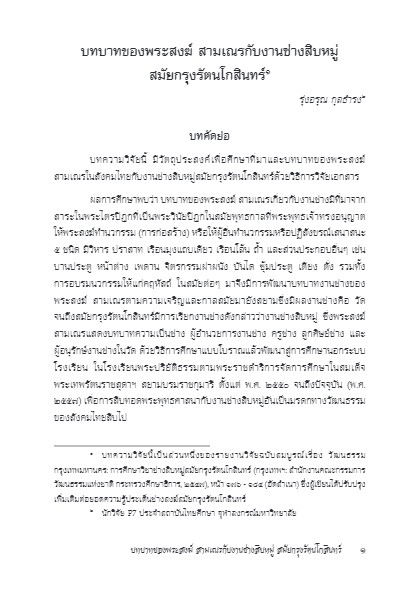รุ่งอรุณ กุลธำรง
บทคัดย่อ
บทความวิจัยนี้ มีวัตถุประสงค์เพื่อศึกษาที่มาและบทบาทของพระสงฆ์ สามเณรในสังคมไทยกับงานช่างสิบหมู่สมัยกรุงรัตนโกสินทร์ด้วยวิธีการวิจัยเอกสาร
ผลการศึกษาพบว่า บทบาทของพระสงฆ์ สามเณรเกี่ยวกับงานช่างมีที่มาจากสาระในพระไตรปิฎกที่เป็นพระวินัยปิฎกในสมัยพุทธกาลที่พระพุทธเจ้าทรงอนุญาตให้พระสงฆ์ทำนวกรรม (การก่อสร้าง) หรือให้ผู้อื่นทำนวกรรมหรือปฏิสังขรณ์เสนาสนะ 5 ชนิด มีวิหาร ปราสาท เรือนมุงแถบเดียว เรือนโล้น ถ้ำ และส่วนประกอบอื่นๆ เช่น บานประตู หน้าต่าง เพดาน จิตรกรรมฝาผนัง บันได ซุ้มประตู เตียง ตั่ง รวมทั้งการอบรมนวกรรมให้แก่คฤหัสถ์ ในสมัยต่อๆ มาจึงมีการพัฒนาบทบาทงานช่างของพระสงฆ์ สามเณรตามความเจริญและกาลสมัยมายังสยามซึ่งมีผลงานช่างคือ วัด จนถึงสมัยกรุงรัตนโกสินทร์มีการเรียกงานช่างดังกล่าวว่างานช่างสิบหมู่ ซึ่งพระสงฆ์ สามเณรแสดงบทบาทความเป็นช่าง ผู้อำนวยการงานช่าง ครูช่าง ลูกศิษย์ช่าง และผู้อนุรักษ์งานช่างในวัด ด้วยวิธีการศึกษาแบบโบราณแล้วพัฒนาสู่การศึกษานอกระบบโรงเรียน ในโรงเรียนพระปริยัติธรรมตามพระราชดำริการจัดการศึกษาในสมเด็จพระเทพรัตนราชสุดาฯ สยามบรมราชกุมารี ตั้งแต่ พ.ศ. 2550 จนถึงปัจจุบัน (พ.ศ.2557) เพื่อการสืบทอดพระพุทธศาสนากับงานช่างสิบหมู่อันเป็นมรดกทางวัฒนธรรมของสังคมไทยสืบไป
(ตีพิมพ์ใน วารสารไทยศึกษา ปีที่ 10 ฉบับที่ 2 (สิงหาคม 2557 – มกราคม 2558) หน้า 1-37)
The Role of Buddhist Monks and Novices with Respect to the Ten Thai Arts and Crafts during the Rattanakosin Period
Rungaroon Kulthamrong
Abstract
The aim of this research article is to focus on the tradition and the role of Buddhist monks and novices with respect to the Ten Thai Arts and Crafts during Rattanakosin Period.
The research found that the role of monks and novices as related to arts and crafts work can be traced to the Tripitaka Buddhist Scriptures in the section of monastic disciplines or Vinaya Pitaka. There is evidence from the time of the Buddha that monks received the Buddha’s permission in conducting Navakam (construction) by themselves or supervising someone in the repair of five kinds of Senasana (lodgings): temples; central shrines; traditional thatched-roof houses; empty abodes or uninhabited spots; and caves – including the structural elements of door panels, windows, ceilings, moral paintings, stairs, arched entrances, beds, and stools. The role of monks and novices also included training in Navakam for laymen. Their roles in arts and crafts work developed onward to the Rattanakosin Period of Siam with prominent construction work in monasteries which has been codified into the Ten Arts and Crafts Work. The monk and novice’s craftsmanship includes the roles of craftsman, supervisor, instructor or trainer, disciple, and conservator pertinent to the monasteries. Through the study on traditional construction, some standardization has been developed institutionally into the system of the Non-Formal Education established in the Dhamma Studies School according to the ideas regarding educational management of Somdej Phra Thep Rattana Rajasuda Siam Boromraja Kumaree since 2007 until the present time (2014). This systematized direction has continuously maintained the connection between Buddhism and the Ten Arts and Crafts Work as a cultural inheritance in Thai society.
(Published in Journal of Thai Studies Volume 10 Number 2 (August 2014 – January 2015) Page 1-37)
บทความ / Full Text : Download
